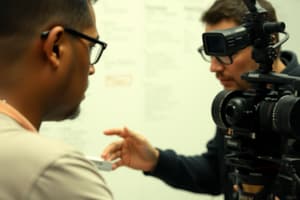Podcast
Questions and Answers
What is the 'host plus standard' interview style?
What is the 'host plus standard' interview style?
- The host and interviewee are both on camera
- The host is off camera, and the interviewee is on camera
- The host and interviewee are off camera
- The host is on camera, and the interviewee is off camera (correct)
What is the main advantage of the 'in the moment' interview style?
What is the main advantage of the 'in the moment' interview style?
- It presents the interviewees in a more natural environment (correct)
- It allows for voiceover narration
- It adds context to the interview by showing what the host is looking at
- It encourages engaging conversation
In the 'standard voiceover' interview style, what happens?
In the 'standard voiceover' interview style, what happens?
- Both host and interviewee are on camera
- Interviewee's voice is narrated over b-roll footage (correct)
- Interviewees are engaged in an activity while being interviewed
- The host is on camera, but the interviewee is off camera
What is a potential downside of not executing the conversational style well?
What is a potential downside of not executing the conversational style well?
What does the 'in the moment' interview style aim to achieve?
What does the 'in the moment' interview style aim to achieve?
Which interview style involves the interviewer looking directly into the camera lens while interviewing the interviewee?
Which interview style involves the interviewer looking directly into the camera lens while interviewing the interviewee?
What is the main challenge of the conversational interview style?
What is the main challenge of the conversational interview style?
What is the suggested position for the interviewee in the standard interview style to avoid deep shadows on their face?
What is the suggested position for the interviewee in the standard interview style to avoid deep shadows on their face?
What adds depth and creates a more cinematic feel in the standard interview style?
What adds depth and creates a more cinematic feel in the standard interview style?
What is a pro of the enterotron interview style?
What is a pro of the enterotron interview style?
Flashcards are hidden until you start studying
Study Notes
- The text discusses various interview styles used in documentary filmmaking.
- The first interview style is called "standard," where the interviewee sits off-camera and the interviewer is close to the lens.
- The suggestion is to place the interviewee with their eyes looking towards the light source to avoid deep shadows on their face.
- Using a floating camera for a side angle adds depth and creates a more cinematic feel.
- The pro of the standard interview style is that it's safe and straightforward, but it may not be the most creative or engaging approach.
- The second interview style is called "enterotron," where the interviewer looks directly into the camera lens while interviewing the interviewee.
- Using a two-way mirror system for this style allows the interviewer to make a direct connection with the audience.
- This style can be more intimate and create a better connection between the audience and the interviewee.
- The con of the enterotron style is that it requires technology, which may not be accessible to all filmmakers.
- The third interview style is called "conversational," where two people are discussing a topic and the interviewer is present on camera.
- The challenge with this style is that it requires the use of two cameras or careful editing to capture the conversation effectively.
- The conversational style is natural and can feel like a real conversation, but if not executed well, it can feel awkward or distant.
- The fourth interview style is called "host plus standard," where the host is on camera, and the interviewee is off camera.
- This style adds context to the interview by showing what the host is looking at.
- The fifth interview style is called "in the moment," where the interviewees are engaged in an activity while being interviewed.
- This style allows the audience to see the interviewees in a more natural environment and can create a more engaging conversation.
- The final interview style is called "standard voiceover," where the interviewee is not on camera, and their voice is narrated over b-roll footage.
- Voiceover can be an effective way to tell a story without relying on interviews, but it's encouraged to shoot the interview for potential use.
Studying That Suits You
Use AI to generate personalized quizzes and flashcards to suit your learning preferences.




